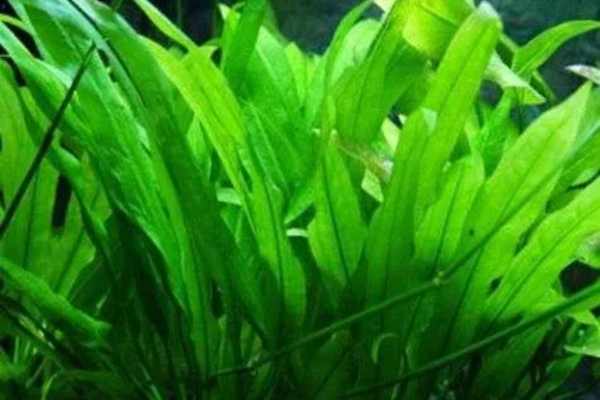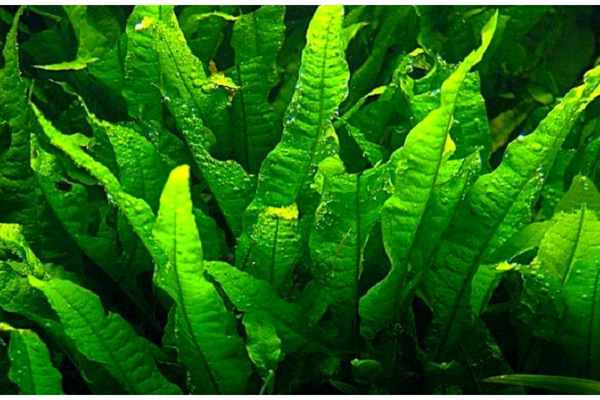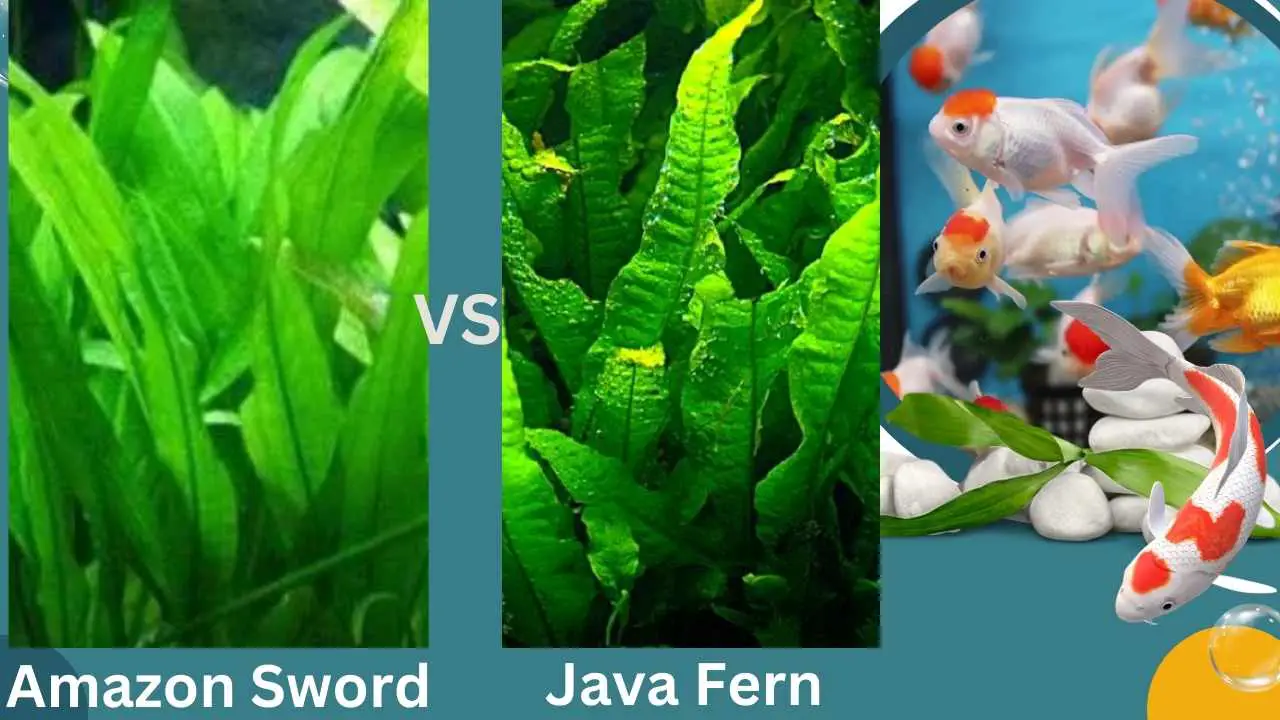The Amazon Sword (Echinodorus amazonicus) and Java Fern (Microsorum pteropus) are two popular aquatic plants that are often used in aquariums to create a natural and attractive underwater environment. These plants are known for their unique physical characteristics and low maintenance requirements, making them ideal for both beginner and experienced aquarists. In this comparison, we will examine the differences between the Amazon Sword and Java Fern, including their size and growth, leaf shape and color, and maintenance and care requirements. By understanding these differences, aquarists can make an informed decision when choosing plants for their aquarium.
Systematic Position
Amazon Sword
Kingdom: Plantae
Clade: Angiosperms
Order: Alismatales
Family: Alismataceae
Genus: Echinodorus
Species: Echinodorus amazonicus
Java Fern
Kingdom: Plantae
Clade: Angiosperms
Order: Alismatales
Family: Polypodiaceae
Genus: Microsorum
Species: Microsorum pteropus


Habit and Distribution
Amazon Sword (Echinodorus amazonicus) is a species of aquatic plant native to South America, specifically the Amazon Basin in Brazil. In the wild, it grows in slow-moving or still bodies of water and can reach up to 30 cm in height.
Java Fern (Microsorum pteropus) is native to Southeast Asia and is commonly found in slow-moving rivers and streams. It is a slower growing plant, typically reaching 15 cm in height, and is known for its delicate, needle-like leaves.
Both Amazon Sword and Java Fern have become popular in aquariums around the world due to their ease of care and attractive appearance. They can be found in most pet stores that sell aquarium supplies and are available for purchase online. In aquariums, they are often used as background plants or as centerpiece plants to provide a natural and attractive underwater environment.
Physical Characteristics of Amazon Sword and Java Fern
Size and Growth
Amazon Sword is a large, rosette-forming plant that can reach up to 30 cm in height. It has a fast growth rate and is capable of rapidly filling a space in an aquarium. It forms dense clumps of leaves, and can be trimmed or pruned to maintain its shape and size in the aquarium.
Java Fern is a slower growing, more compact plant that typically reaches only 15 cm in height. It has a slower growth rate and is a good choice for smaller aquariums or for use as foreground or midground plants. Java Fern does not spread as quickly as Amazon Sword and does not form dense clumps of leaves. Instead, it grows in a more upright and vertical habit, making it a good choice for creating contrast in the aquarium.
Leaf Shape and Color
The leaves of Amazon Sword are broad and bright green in color, giving the plant a lush, tropical appearance. The leaves can reach up to 20 cm in length and are slightly serrated along the edges.
The leaves of Java Fern are delicate and needle-like, growing to only 10 cm in length. They are a dark green color and are often used to provide contrast in an aquarium. Unlike the broad leaves of Amazon Sword, the leaves of Java Fern are thin and delicate, creating a softer appearance in the aquarium.
Maintenance and Care of Amazon Sword and Java Fern
Light Requirements
Both Amazon Sword and Java Fern are low-light tolerant and can grow well in a wide range of lighting conditions. However, they do benefit from some supplemental lighting, which can help enhance their growth and color.
Propagation Methods
Amazon Sword can be propagated by dividing the plant when it becomes too large for its container. Simply remove the plant from the aquarium and separate it into smaller sections, each with a healthy root system.
Java Fern does not produce flowers and is typically propagated through fragments or daughter plants that develop near the base of the plant. To propagate, simply remove a fragment of the plant and attach it to a rock, wood, or other surface in the aquarium.
Fertilization Needs
Neither Amazon Sword nor Java Fern requires added fertilizers to grow. They are capable of obtaining the nutrients they need from the aquarium water and do not need additional supplements. In fact, over-fertilization can be harmful to these plants and should be avoided.
Water Quality Requirements
Both Amazon Sword and Java Fern are tolerant of a wide range of water conditions, making them ideal for aquariums with varying water quality. However, they do prefer water that is clean and well-oxygenated. They are also sensitive to high levels of nitrates and phosphates, which can cause the plants to become stunted or die.
In terms of water temperature, Amazon Sword and Java Fern can both tolerate temperatures ranging from 60°F to 80°F. They are not recommended for very warm aquariums or for aquariums with rapidly fluctuating temperatures.
When it comes to water hardness, Amazon Sword and Java Fern are both fairly tolerant, but they do prefer water that is slightly acidic to neutral (pH 6.0 to 7.5). They can survive in water with a higher pH, but this can cause the leaves to yellow and become stunted.
To ensure plants remain healthy and thriving in the aquarium, regular water changes and water quality testing should be done.
Suitable Tankmates
Both Amazon Sword and Java Fern are generally compatible with a wide range of aquarium inhabitants, making them suitable for use in a variety of aquarium setups.
Amazon Sword can be kept with a variety of freshwater fish, including tetras, angelfish, and cichlids. It is also suitable for use in community aquariums, as it is not known to harm other aquatic plants or invertebrates.
Java Fern is also a good choice for community aquariums, as it is compatible with a wide range of fish, including tetras, guppies, and shrimps. It is also suitable for use in aquariums with other aquatic plants, as it is not known to cause any harm to other plants in the aquarium.
Suitable Substrates
Both Amazon Sword and Java Fern can be grown in a variety of substrates, including sand, gravel, and soil. However, each plant has different preferences and requirements.
Amazon Sword is a robust plant that can be grown in a wide range of substrates. It prefers a substrate that is rich in organic matter and nutrients, such as soil or a mixed substrate of sand and soil. This will help the plant grow strong roots and establish itself in the aquarium.
Java Fern, on the other hand, does not have strong root systems and does not require a nutrient-rich substrate. In fact, it is often grown attached to rocks, driftwood, or other hardscapes in the aquarium. Java Fern does not need to be planted in substrate and can simply be attached to a hard surface in the aquarium.
Benefits of Amazon Sword and Java Fern in the Aquariums
Water Quality Improvement
Both Amazon Sword and Java Fern are highly effective at improving water quality in an aquarium. They absorb excess nutrients, such as nitrates and phosphates, which can cause algae blooms and other water quality issues. By removing these excess nutrients, the plants help maintain a healthy, balanced aquarium ecosystem.
Providing Habitat for Aquatic Life
Both Amazon Sword and Java Fern provide a natural and attractive habitat for various aquatic life, including fish, snails, and other aquatic invertebrates. The leaves and stems of these plants offer shelter and spawning sites for fish, and the roots provide a hiding place for other aquatic creatures.
Compatibility with Aquarium Conditions
Both Amazon Sword and Java Fern are highly compatible with a wide range of aquarium conditions. They are low-maintenance and can tolerate a wide range of water temperatures, water hardness levels, and lighting conditions. They are also highly versatile and can be used as background plants, foreground plants, or as centerpiece plants in the aquarium. They are a popular choice for both beginner and experienced aquarists alike.
Diseases and Treatments
Both Amazon Sword and Java Fern are relatively hardy plants that are resistant to most common aquarium diseases. However, like all plants, they can still be affected by various diseases if the conditions in the aquarium are not optimal.
Common diseases that can affect Amazon Sword include yellowing leaves, stunted growth, and root rot. These issues can often be caused by poor water quality, insufficient light, or over-fertilization. To treat these issues, you should improve the water quality, increase the light, and reduce the amount of fertilizer you use.
Java Fern is also relatively hardy, but it can be affected by brown or black spots on the leaves, yellowing leaves, or stunted growth. These issues can often be caused by poor water quality, low light, or high levels of copper in the water. To treat these issues, you should improve the water quality, increase the light, and make sure that the water does not contain high levels of copper.
Which Plant Is Better Choice for Aquarium?
It’s difficult to say which is the better choice for an aquarium as it largely depends on personal preference and the conditions in the tank. Both Amazon Sword and Java Fern have their own unique characteristics and benefits, and each may be more suitable for different aquarium setups and conditions.
If you are looking for a fast-growing plant that can form dense clumps of leaves and provide habitat for aquatic life, Amazon Sword may be a good choice. It prefers a nutrient-rich substrate and bright light, and can be trimmed or pruned to maintain its shape and size in the aquarium.
If you are looking for a slower-growing plant with a more upright habit that does not need to be planted in substrate and can be attached to hardscapes in the aquarium, Java Fern may be a better choice. It is also a good option if you have low light levels or low nutrient levels in the water.
Both Amazon Sword and Java Fern are attractive and hardy plants that can add beauty and interest to your aquarium, so it is worth considering both options when selecting plants for your tank.
Frequently Asked Questions
Question-1: Which Is Easier to Care For, Amazon Sword or Java Fern?
Answer: Both Amazon Sword and Java Fern are relatively easy to care for, but they have different requirements and preferences for light, water quality, and substrate. Java Fern may be easier to care for as it does not need to be planted in substrate and is more tolerant of low light levels, but Amazon Sword is relatively hardy and can be trimmed or pruned to maintain its shape and size in the aquarium.
Question-2: Which Is More Suitable for Low Light Aquariums, Amazon Sword or Java Fern?
Answer: Java Fern is more suitable for low light aquariums as it does not require bright light to grow and can be attached to hardscapes in the aquarium. Amazon Sword prefers bright light and a nutrient-rich substrate.
Question-3: Can Amazon Sword and Java Fern Be Planted Together in the Same Aquarium?
Answer: Yes, Amazon Sword and Java Fern can be planted together in the same aquarium, but it is important to consider the conditions in the tank, including the light levels, water quality, and the other plants and animals in the tank.
Question-4: What Are the Best Tankmates for Amazon Sword and Java Fern?
Answer: Both Amazon Sword and Java Fern are compatible with a variety of tankmates, including fish, snails, and other aquatic plants. It is important to consider the water quality requirements and compatibility of the other plants and animals in the tank when choosing tankmates for your aquarium.
Conclusion
Amazon Sword and Java Fern are both popular and attractive aquatic plants that are suitable for aquariums. Both plants are relatively hardy and resistant to most common aquarium diseases, but it is important to provide them with the right conditions to keep them healthy and disease-free.
When deciding between Amazon Sword and Java Fern, it is important to consider the conditions in your aquarium, including the light levels, water quality, and the other plants and animals in the tank.
In conclusion, whether you choose Amazon Sword or Java Fern, both plants can add beauty and interest to your aquarium and provide habitat for aquatic life.

